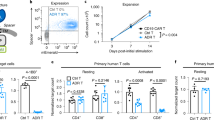Abstract
IMMUNOLOGICAL responses to histoincompatible tissues and to tumour cells are mediated by thymus-derived (T) lymphocytes. The cells that effect these responses have been termed cytotoxic T-killer cells and are derived from T-precursor cells that have become programmed (committed) to recognise specific antigenic determinants. The generation of T-effector or killer cells involves the collaboration of two distinct subpopulations of T cells. Helper T cells interact with specific precursor T cells when stimulated by antigen and, during the resultant differentiation processes, the precursor clones mature into specific killer cells1–3. The nature or mechanisms of the collaboration between the precursor and helper T cells has been obscure until now. The data presented here demonstrate that soluble T-cell products can replace the requirement for helper T cells in the generation of T-killer cells. The active substances are produced on antigenic stimulation and are as effective as T-helper cells during the differentiation of precursor T cells into killer cells.
This is a preview of subscription content, access via your institution
Access options
Subscribe to this journal
Receive 51 print issues and online access
$199.00 per year
only $3.90 per issue
Buy this article
- Purchase on Springer Link
- Instant access to full article PDF
Prices may be subject to local taxes which are calculated during checkout
Similar content being viewed by others
References
Wagner, H., J. exp. Med., 138, 1379–1397 (1973).
Anderson, L. C., Hayry, P., Bach, M. A., and Bach, J. F., Nature, 252, 252–254 (1974).
Cantor, H., and Boyse, E. A., J. exp. Med., 141, 1376–1399 (1975).
Plate, J. M. D., Eur. J. Immun., (in the press).
Sachs, D. H., and Cone, J. L., J. exp. Med., 138, 1289–1304 (1973).
Brunner, K. J., Manuel, J., Cerotini, J. C., and Chapius, B., Immunology, 14, 181–196 (1968).
Boyse, E. A., Hubbard, L., Stockert, E., and Lamm, M. E., Transplantation, 10, 446–449 (1970).
Plate, J. M. D., and McKenzie, I. F. C., Nature new Biol., 245, 247–249 (1973).
Dutton, R. W., et al., Progr. Immun., 1, 355–368 (1971).
Schimpl, A., and Wecker, E., Nature new Biol., 237, 15–17 (1972).
Feldman, M., and Basten, A., Nature new Biol., 237, 13–15 (1972).
Doria, G., Agarossi, G., and Di Pietro, S., J. Immun., 108, 268–270 (1972).
Britton, S., Scand. J. Immun., 1, 89 (1972).
Gorczynski, R. M., Miller, R. G., and Phillips, R. A., J. Immun., 108, 548–554 (1972).
Sjoberg, O., Andersson, J., and Moller, G., J. Immun., 109, 1379–1385 (1972).
Armerding, D., and Katz, D. H., J. exp. Med., 140, 19–37 (1974).
Armerding, D., Sach, D. H., and Katz, D. H., J. exp. Med., 140, 1717–1722 (1974).
Munro, A. J., and Taussig, M. J., Nature, 256, 103–106 (1975).
Author information
Authors and Affiliations
Rights and permissions
About this article
Cite this article
PLATE, J. Soluble factors substitute for T–T-cell collaboration in generation of T-killer lymphocytes. Nature 260, 329–331 (1976). https://doi.org/10.1038/260329a0
Received:
Accepted:
Issue Date:
DOI: https://doi.org/10.1038/260329a0
This article is cited by
-
Die Rolle von Interleukin-2 bei der Aktivierung von zytotoxischen T-Lymphozyten
Klinische Wochenschrift (1983)
-
Direct evidence for a two-signal mechanism of cytotoxic T-lymphocyte activation
Nature (1980)
Comments
By submitting a comment you agree to abide by our Terms and Community Guidelines. If you find something abusive or that does not comply with our terms or guidelines please flag it as inappropriate.



